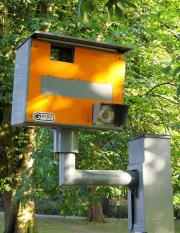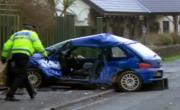Here’s an interesting American article from the Lancaster Eagle Gazette.
It claims that in the last month there have been at least 12 serious crashes in Ohio, where the driver overcorrecting from a lesser situation made the whole thing far worse.
Bill Alsnauer, an agent for State Farm Insurance in Ohio, said most of these instances [the initial situation that prompted the overcorrection] are due to distracted drivers, and people not leaving enough distance between themselves and the vehicle ahead of them.
That’s the same wherever you go, of course. Alsnauer adds:
Younger drivers sometimes think the best way out of a situation is speed, and doing things quickly.
He could have added that being too confident of one’s skills is also contributory – in the UK, that would definitely be true, especially of young drivers.
Randy Hall, a driver trainer (equivalent to an ADI over here), points out:
…a common instance of overcorrecting is when one slams on the brakes after leaving the roadway.
If only one wheel is on the road, this leads to unequal braking that causes the car to go to the left…
Wendy Haar, another trainer, says:
…it’s important for motorists to know if the vehicle they are driving has anti-lock brakes, which helps the uneven braking problem…
And Chris Troupe – also a trainer – says:
overcorrecting is caused by improper hand techniques when spinning the wheel. Also… young drivers often turn the wheel the wrong way; they should steer in the direction they want the car to go.
People will end up with their hands crossed, they’re not using their hand-over-hand techniques…They basically run out of room to turn.
As an aside, this highlights one of the things I’ve pointed out many times before about “crossing hands” and ”hand-over-hand” steering in the UK. Troupe is referring to gripping the wheel and swinging it round with the hands fixed, as opposed to reaching over and pulling the wheel as necessary. It’s one of the first things learners have to be tutored out of, as they usually automatically fix their hands when steering and run out of anywhere to go once they cross their hands at the forearm position. But hand-over-hand is totally different.
In fact, a lot of ADIs actually stop people using hand-over-hand steering as if it were a fault. I get quite a few pupils who’ve been told not to – when there is absolutely no reason why they shouldn’t.
The only difference between the UK and the USA appears to be that over here, the preferred steering method is pull-push (with hand-over-hand being fine for rapid, slow-speed steering), whereas the Americans teach hand-over-hand.
But back to the point of the story, the article concludes by saying:
The biggest contributor to overcorrecting is when panic sets in.
When you panic, your mind shuts off and you don’t think logically…
The article stops short of making any recommendations, even though it is effectively saying that you may know what to do, but you won’t do it when you have to.
I guess the whole point is not to get into the predicament to start with. As ADIs, we should train this into people. We should also make sure they know what they should do if they do get into a pickle – but beyond that, what else is there?
If panic stops people doing what they would ordinarily know to do, no amount of training is going to alter that. So the primary focus has to be on prevention, surely?
 He was breathalysed and gave a result of 125µg/100ml (the limit is 35µg).
He was breathalysed and gave a result of 125µg/100ml (the limit is 35µg). I found this link from
I found this link from 
 According to the BBC, South Gloucestershire could join Somerset in turning off its speed cameras after funding runs out at the end of March.
According to the BBC, South Gloucestershire could join Somerset in turning off its speed cameras after funding runs out at the end of March. 23-year old Nathan Morris of Tenby was selling a car – a Peugeot hatchback – and Gavin Collier (20) went to look at it. Morris took the car out with Collier as the passenger to test drive it and crashed into a parked car whilst travelling at “up to 75mph in a 50mph zone”.
23-year old Nathan Morris of Tenby was selling a car – a Peugeot hatchback – and Gavin Collier (20) went to look at it. Morris took the car out with Collier as the passenger to test drive it and crashed into a parked car whilst travelling at “up to 75mph in a 50mph zone”.